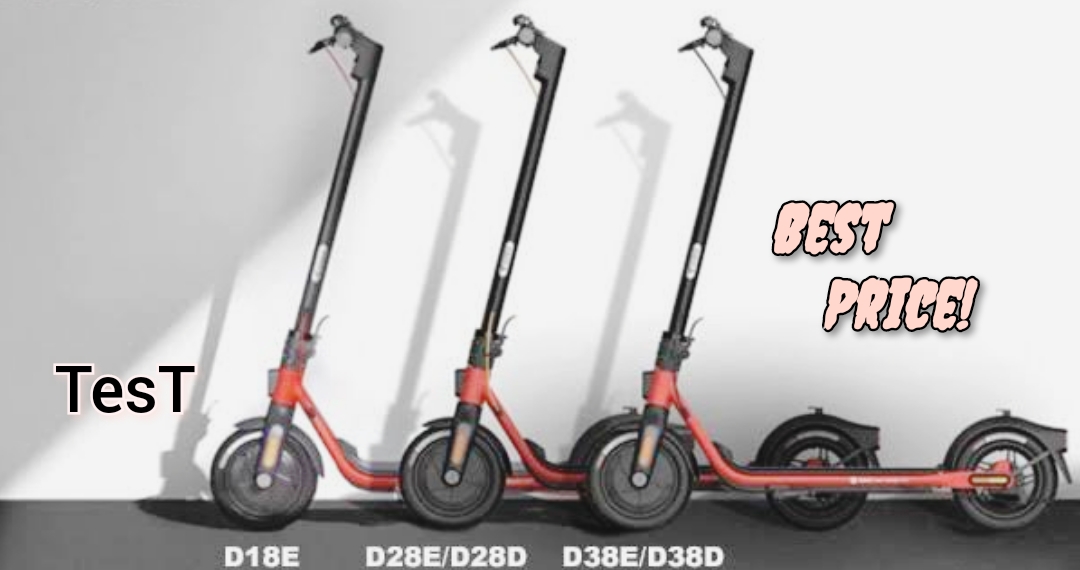Ninebot KickScooter D28D for €379.60 & D38D for €529 at Amazon. Here, are the all reviews, specs, prices & photos. Highlights at a glance:
- 28 km range
- 120 kg transport weight
- 300w engine power & street legal
The Segway-Ninebot models D28D and D38D are e-scooters adapted for the German market, which originally appeared as the D28E and D38E for the international market. They are now street legal and can of course be driven in this country. We tried the Ninebot D38D and tell you if it’s worth buying.
Ninebot KickScooter D28D / D38D Review, Specs, Price, Photos & Video
- Ninebot Kick Scooter D38D
- Ninebot Kick Scooter D28D
| Model | Ninebot Kick Scooter D28D/ D38D |
| Maximum range | 28 / 38km |
| Maximum speed | 20km/h |
| Maximum transport weight | 120kg |
| battery | 275/ 367 Wh (charging time 5/ 6.5 hours) |
| engine power | 300 / 350W |
| own weight | 15.3/ 16.3 kg |
| Dimensions (length/width/height) | 116×114.3x48cm |
| Dimensions (folded) | 50 x 114.3 x 48cm |
| Price | 439€/ 509€ |
The D stands for Germany
While e-scooters travel at 25 km/h in most countries, they are allowed to drive at a maximum of 20 km/h in Germany. A problem for many manufacturers, as it is of course much cheaper to only put one version of their scooter on the market that can be used anywhere.
There are seldom specially adapted models for the German market. Ninebot has done this in the past (for the first time with the G30D), and the two e-scooters D28D and D38D also fall into this category again.
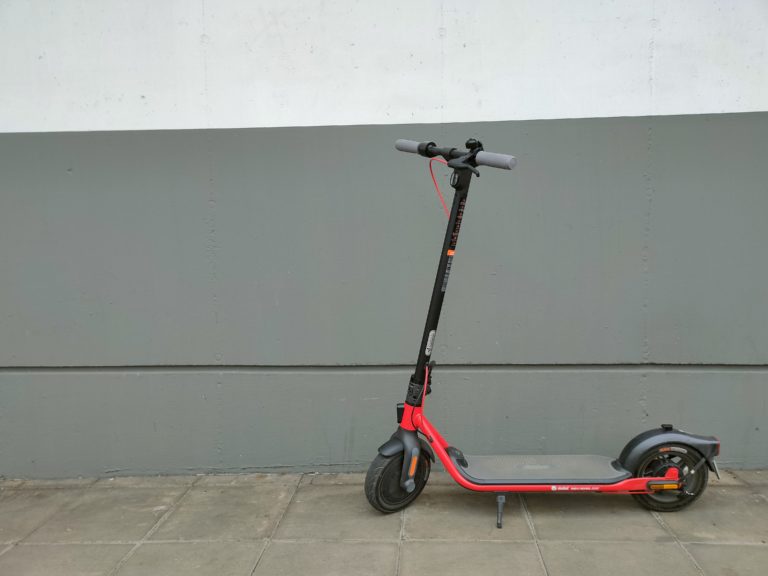
In order to get road approval for Germany, some conditions must be met. The maximum speed must not exceed 20 km/h, and there is also an upper limit for engine power. Lighting and brakes are also mandatory. The two models are equipped with all of this. They are also largely identical, the D38D has a slightly more powerful motor and larger battery, resulting in a longer range and a slightly higher weight.
Greater range, better acceleration
The names of the scooters are not chosen at random, but correspond to the range of the batteries. The D28D should cover 28 kilometers, the D38D accordingly 38. That is not really much, but still on average for e-scooters and is still enough for short commutes of a few kilometers to get through a week with one battery charge. It always depends on the individual case, in my case, for example, I have to charge after three days at the latest.
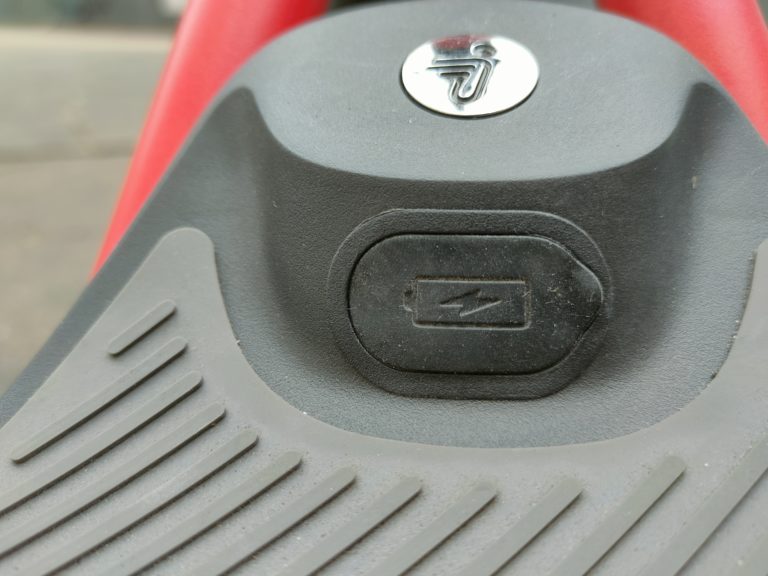

38 kilometers is only the optimal value on paper. In reality, the value is more like 30 kilometers, maybe slightly more. I was able to drive the route several times with one battery charge.
As usual, there are three different driving modes with different acceleration and top speeds. These are called Eco, Drive and Sport. There is also a “walking mode” for driving at walking speed (maximum 5 km/h). The different modes are shown on the display, where you also get an overview of the battery level and current speed. The scooters can also be connected to the smartphone via Bluetooth, where you can then get more information in the associated app.
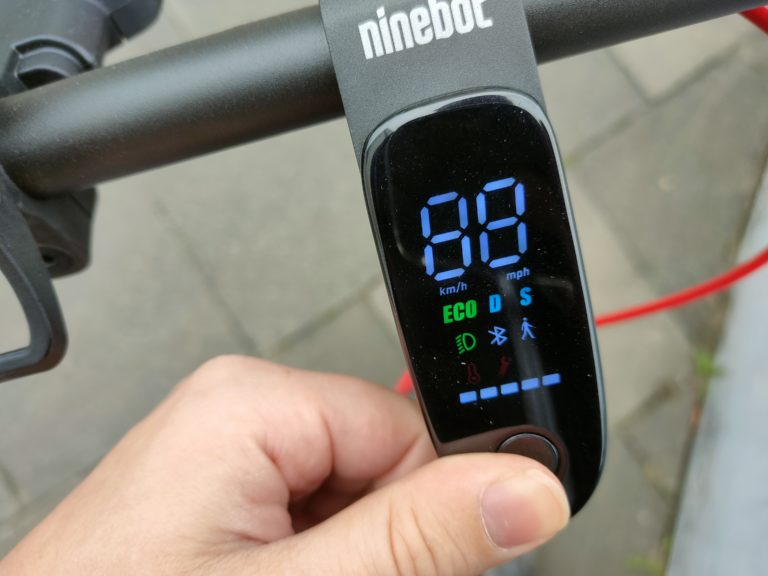
It is noticeable that the engine seems to have a little more power here. First of all, it accelerates really well and comes (with pushing) from a standing start in under 2 seconds to 15 km/h and then accelerates again in 3-4 seconds to 20 km/h. In addition, Ninebot promises a maximum gradient of 20% that can be overcome. It’s harder for me to test that in detail, but I’ve rarely had a scooter that managed so well on a slope. In my opinion one of the greatest strengths of the D38D.
The D38D in everyday commuting
Let’s give an example of what this looks like in practice (from the point of view of a train commuter). On my commute to work, I typically take the tram (stops a minute from my front door) to the train station for just under 20 minutes, then a 15-minute train ride, and then a >10-minute walk to the office. Including waiting times, that’s 45 minutes – provided the train is on time.
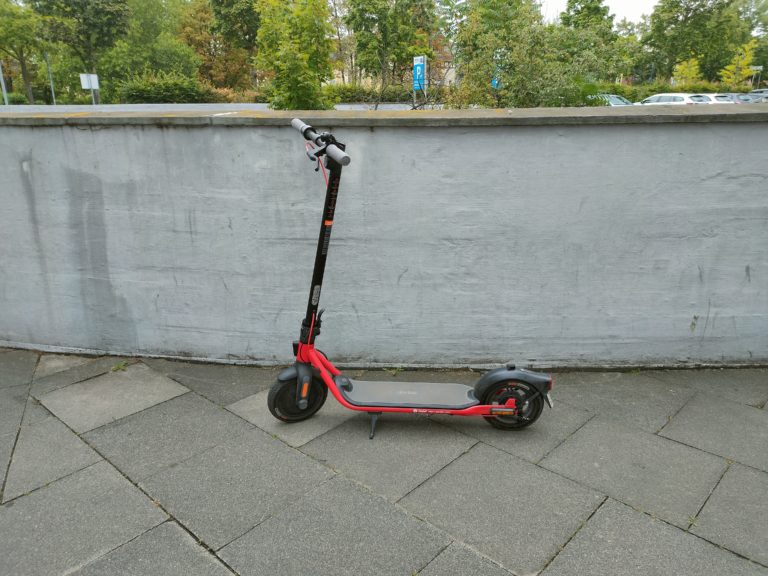
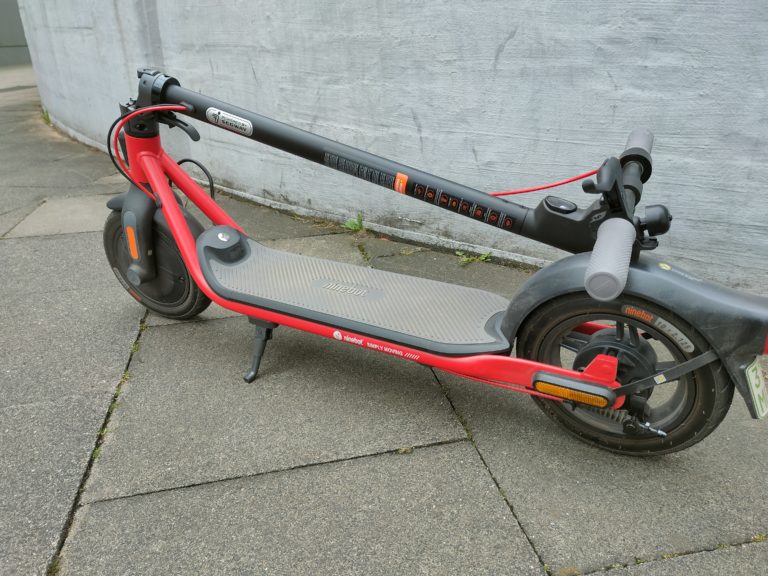
Since we have the D38D here, I regularly use the scooter for this route. It looks like I drive the 5 kilometers to the train station directly with the scooter, which also takes about 20 minutes. I can leave the house 15 minutes later because I don’t have to plan a waiting time for the tram and calculate with a possible delay.
The subsequent train ride remains the same, only that I have the scooter with me, which is not a problem even to the fullest and takes up significantly less space than a bicycle. The 10 minutes to the office become 3 minutes with the scooter.
At 5-6 kilometers per route and corresponding to 10-12 kilometers per day, I can do this for a maximum of three days in a row with one battery charge, but I usually recharge the scooter after two days.
Pros and cons from my personal perspective:
- ➕ I’m much more flexible with the scooter. I’m not dependent on the tram, but I can get on at any time if I change my mind, be it because of the weather or because I’m economical with the battery charge.
- ➕ Overall, I’m faster than by (tram) train. At least downtown.
- ➕ In an emergency I drive the whole distance with the scooter. Okay, that’s 17 kilometers and at 20 km/h I’m on the road for a full hour. I’ve only done it once now. Depending on the delay situation of the train (the Düsseldorf-Cologne route has been extremely plagued by construction sites, delays and cancellations for weeks), this is still the more pleasant way to travel. And it’s faster then too. I would rather stand on the e-scooter for an hour and be in the open air and by myself than spend the same amount of time on the platform and in the overcrowded and late train.
- ➕ I just list the running costs here as a plus point. There are different estimates for e-scooters, but they are all around €10 in electricity costs per year with regular use. Even with rising electricity costs, this remains a minimal cost item. Almost negligible compared to what a train ticket or even driving a car costs me.
- ⛔ I’m a bit dependent on the weather. At least in the rain, riding an e-scooter is not that pleasant, especially over longer distances.
- ⛔ At the same time, I’m less flexible when I’m on the road, because I have a scooter with me. I can’t always take it with me on the bus. And to park the scooter and go shopping spontaneously, you should at least have a lock with you.
Strictly speaking, the points all apply to the bicycle (apart from the place in the train), but whether I cycle for 45 minutes or fully automatically with the scooter also makes a difference. I am also aware that this is a big-city perspective and only works that way if there is a sufficient connection to public transport. Nevertheless: As a supplement to train travel, an e-scooter is a very pleasant thing and I am currently enjoying this longer “test” of the D38D very much.
Amenities/Security
Back to the D38D. With a weight of 16.3 kg, the scooter is slightly heavier than the average of comparable models. As always, the frame can be folded up with just one movement. I struggled a bit at the beginning because the adjusting screw was tightened way too tight. Hence my direct tip: If the lever is too difficult to move, you can loosen it with an Allen key.
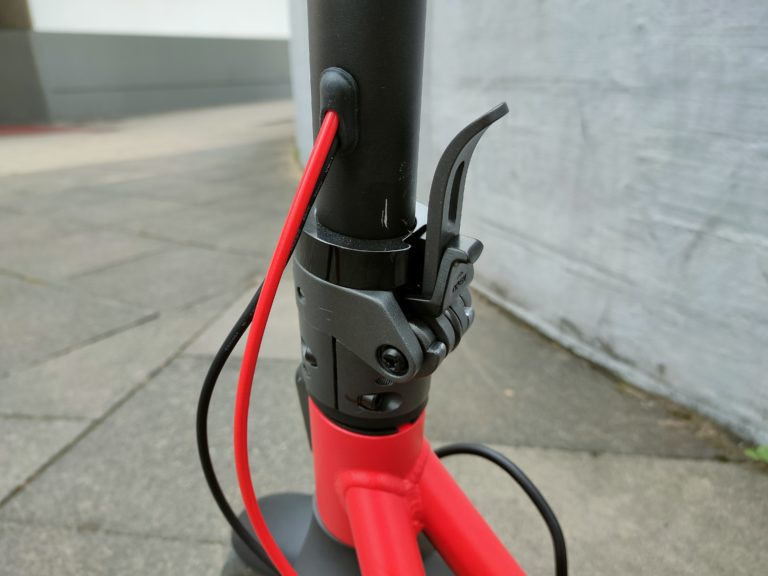
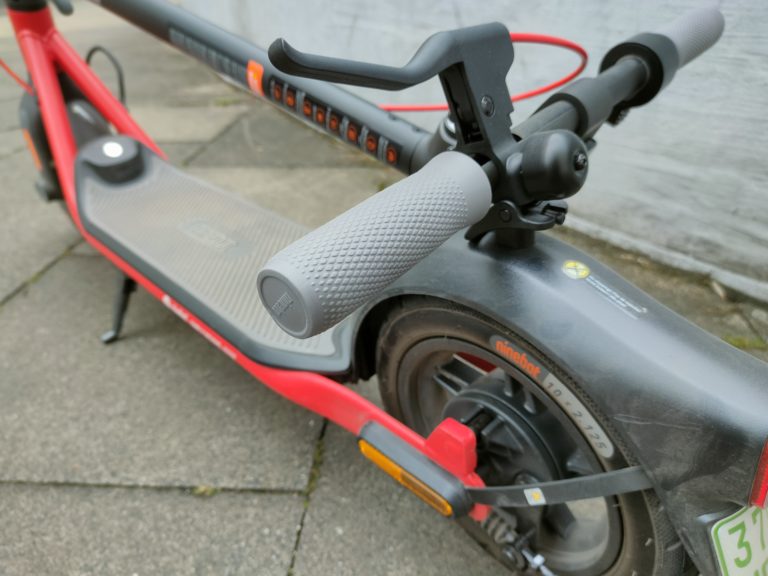
A special feature are the 10-inch pneumatic tires. This is significantly larger than the usual 8 or 8.5 inches and ensures a safer driving experience and more stability. You still can’t (or shouldn’t) crash into curbs with them, but they are still better than smaller tires.
The two brakes are an electronic brake system on the front wheel and a drum brake on the rear wheel. Here I have one of the few criticisms of the D38D. Both brakes are operated simultaneously via a single brake handle. Basically, that’s okay and the scooter brakes sufficiently well. The braking distance at 20 km/h is just under 3 meters for a body weight of approx. 80 kg in the event of an emergency stop.
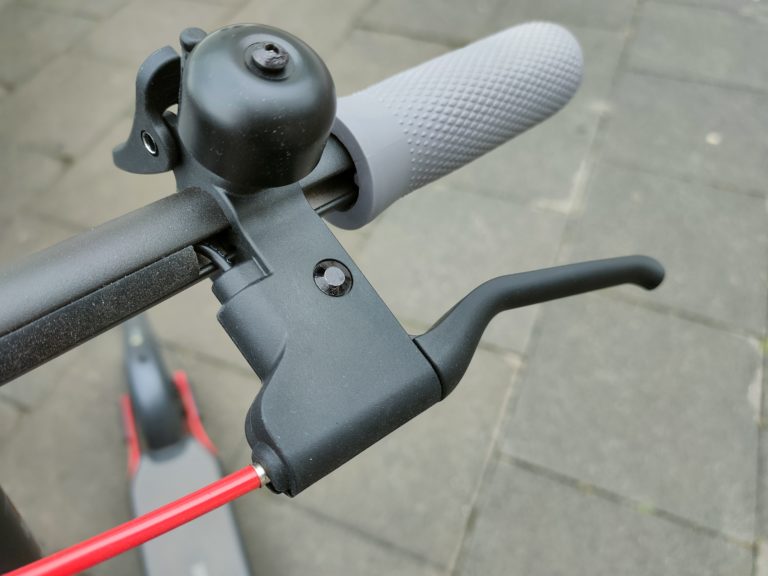
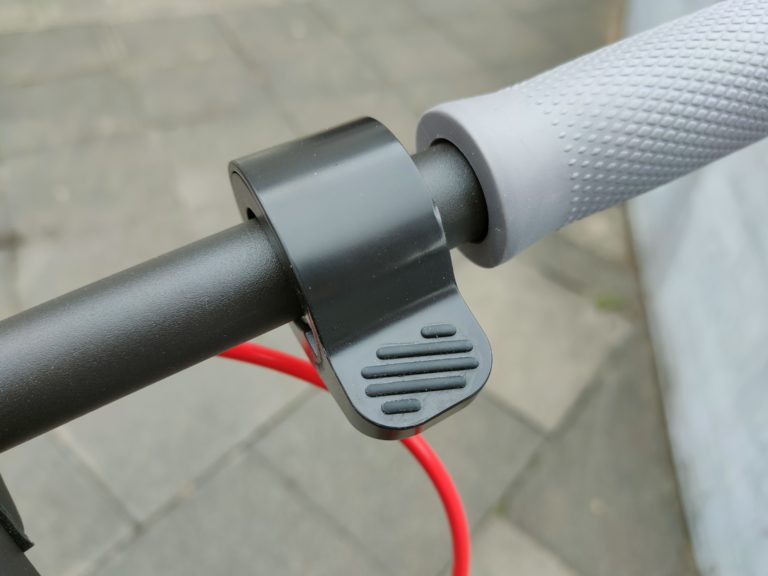
However, the electronic brake switches off at about 3 km/h – this is also the speed at which the engine only starts when pushing. This causes the scooter to “jerk” a little just before it stops. At 3 km/h this is less dramatic and not a big risk, but it can surprise you from time to time.
This is particularly annoying when rolling down a slope at low walking speed with the brakes on. The scooter then regularly comes to a standstill because the electronic brake is constantly switching on and off.
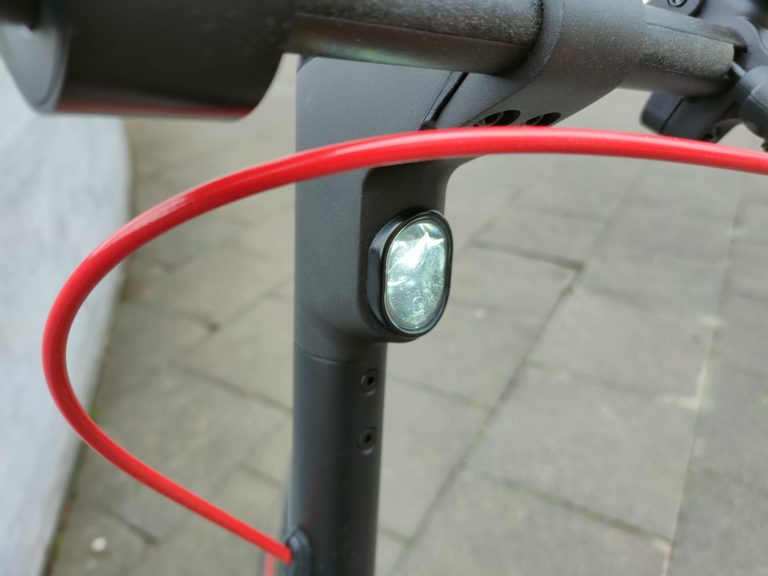

As mentioned, there is also the prescribed lighting in the form of LEDs at the front and rear, as well as additional reflectors on all sides. The headlights are switched on or off by pressing the display button three times. Since you change the mode by pressing twice, this always happens and you have to set the previous mode again afterwards.
Pricing and Availability – Available from mid-July
The international versions D28E and D38E appeared in March 2022; the German models appeared a little late in July 2022. The D28D costs €439, the D38D with the larger battery €509. Slightly more expensive than we would have liked, but maybe cheaper on offer.
We expect “good” e-scooters here, Segway-Ninebot simply have many years of experience on their side and already many excellent models on the market. These two scooters also make a good impression, the data sheet reads consistently interesting. In terms of pure numbers, however, there is not much difference to the (numerous) competition. But if you make a good offer at the price, then the brand name should be the deciding factor for many, as it simply stands for reliability.
My conclusion about the Ninebot Kickscooter D38D
The D38D does a lot right and only a few wrong. It accelerates refreshingly well and cuts a fine figure, especially on inclines. With a range of around 30 kilometers, you can get anywhere in the city and back. The slightly wider running board is also a nice change. The brakes work very well, at least when braking hard.
The fact that the electronic brakes switch off at 3 km/h may be annoying, but it’s not a knock-out criterion. The weight of the scooter could be too heavy for some, there are definitely lighter alternatives and 13 instead of 16 kg actually make a difference – but also in the range, since the battery is then usually smaller.
At €509, the Ninebot D38D is between the Mi Scooter 1S (€400), Xiaomi Electric Scooter 4 Pro and Mi Scooter Pro 2 (€550), with which I am simply comparing the scooter here. Range is also in between, with the D38D accelerating better and being a little more comfortable to drive overall. However, you rarely had to pay the RRP for both Xiaomi models, as there were always offers. I would also look out for those with the Ninbot D38D, but then I can wholeheartedly recommend the scooter.
